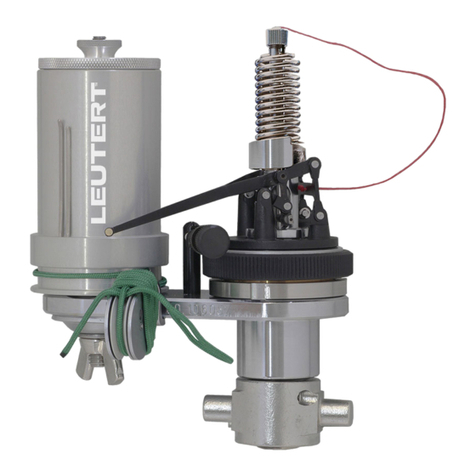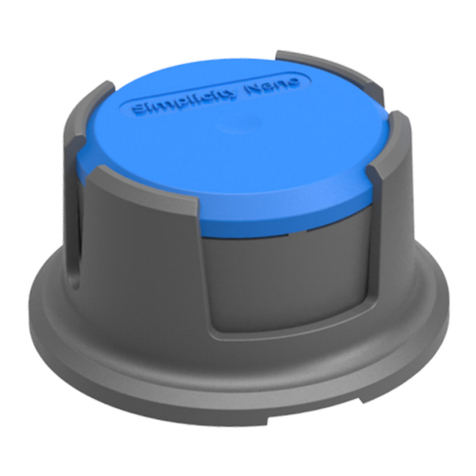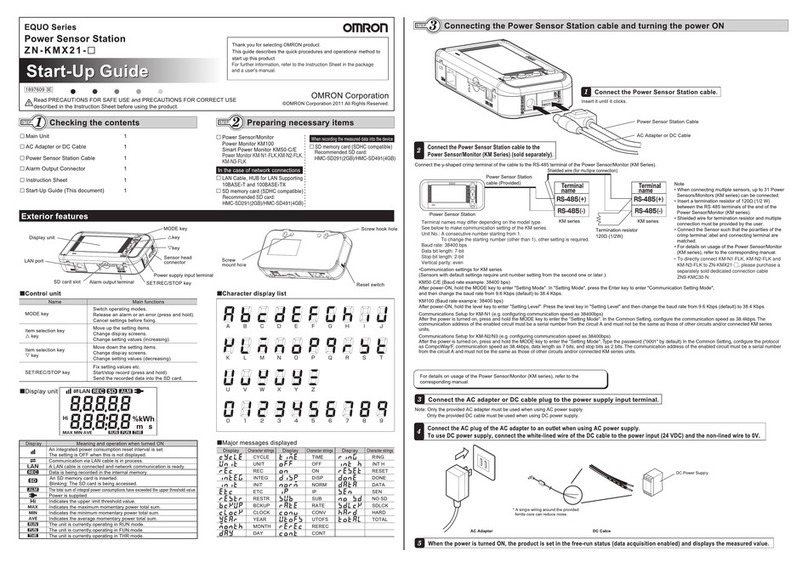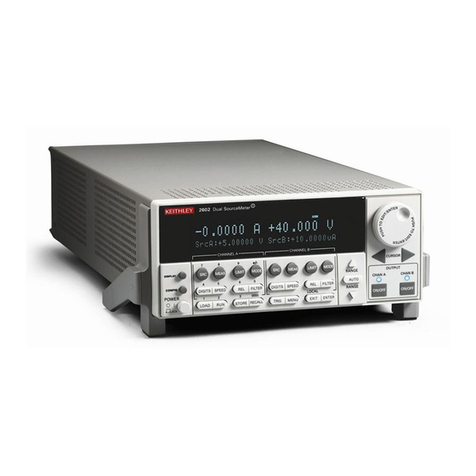Flocorp UltraFlo UFD3 User manual

1
User’s
Manual
Ultrasonic Flow Meter
User Manual
Small Pipe Solution
UltraFlo™ UFD3
ULTRASONIC CLAMP-ON FLOW
METER

2
Preface
Thanks for purchasing the product!
The User’s Manual covers functions, settings, wiring and troubleshooting methods of this
flowmeter. Please carefully read this manual before use.
After reading the manual, please keep it in a proper place for reference when you operate
the flowmeter.
Notes
Any modifications concerning function update in this manual will not be notified.
This manual has been carefully checked, if you find anything improper or any errors,
If there are any differences between the flow meter and its descriptions in this manual,
please take the final product as standard.
DO NOT fully or partially reprint or reproduce this manual.
Version
2022-V1
Warnings
For your safety, please carefully read the following safety warnings before use.

3
Contents
1.1 Product Liabilities and Quality Assurance........................................................5
1.2 Descriptions of the Flow Meter.......................................................................6
Chapter II Descriptions of the Flow Meter ...................................................................6
2.1 Delivery Scope................................................................................................6
2.2 Measuring Principle........................................................................................7
2.3 Application Scope...........................................................................................7
Chapter III Electrical Connections .................................................................................8
3.1 Safety Prompts...............................................................................................8
3.2 Electrical Cables used for the Flow Meter........................................................8
3.3 Connecting electrical cables............................................................................9
3.4 Transmitter Connections .............................................................................. 10
Chapter IV Operation Panel and Quick Start ................................................................... 11
4.1 Power on ..................................................................................................... 11
4.2 Keyboard Operation..................................................................................... 11
4.3 Quick Start ................................................................................................... 12
5.2 Pipe Design and Selection............................................................................. 14
5.3 Transducer Installation................................................................................. 16
Chapter VI Operation ..................................................................................................... 21
6.1 Common Functions....................................................................................... 21
6.2 Description of Operation Menus................................................................... 25
Chapter VII Common Faults and Troubleshooting ........................................................... 31
Chapter VIII Communication Interface and Communication Protocol............................... 32
Appendix. Related Measurement Database.................................................................... 39

4
Copyrights and Data Protection
Content of this file has been carefully checked. We don’t promise that the content is totally
correct and completely identical with the latest version.
Content of this file and related products are under protection of USA copyright laws.
Without authorization in writing of the Company, please DO NOT try to reproduce,
transfer, transcribe or translate any parts of the flow meter including the source code to any
languages or computer language in any forms or through electronic, electromagnetic, optical or
other means.
Without authorization in writing of FLO-CORP, please DO NOT reproduce, copy, reprint,
translate or transfer the manual or part of it to any electronic or readable media.
The designations and signs shown on the product are the registered trademark or
trademark of the Company. All other trademarks, product designations or company names
quoted herein are only used for identification and belong to the property of their respective
owners.
Exception Clauses
The manufacturer shall bear no responsibilities for any consequences caused by the product
in use, which include penalties arising from any direct or indirect accidents or indirect losses.
The exception clauses shall be invalid if the manufacturer’s actions are intentional or
the manufacturer has culpable negligence. According to applicable laws, it is not allowed to
confine implied warranties of the product, or it is not allowed or it confines the compensation
of some kind, and these rights are applicable to you, under such cases, the above exception
clauses or confinement may partially or completely inapplicable to you.
As for each purchased product, related product files and the manufacturer’s sales terms
are applicable.
As for the content of these exception clauses, the manufacturer should reserve the right to
make any corrections in any form, at any time or for any reason with no need to issue
any notifications in advance, and shall bear no responsibilities in any forms arising from the
corrections described herein

5
1.1 Product Liabilities and Quality Assurance
The purchaser should judge by himself whether the flowmeter is applicable or not, and shall
bear related responsibilities. The manufacturer would bear no responsibilities for any
consequences arising from the purchaser’s misuse of the flowmeter. The purchaser may lose
the rights for quality assurance if the flowmeter or the system is installed or operated in a
wrong way. In addition, the corresponding “Standard Terms of Sale” is also applicable, and
shall be the basic conditions of the Sales Contract.
Information about this file
To avoid any injuries or any damages to the flowmeter, please DO carefully read this file and
DO comply with local standards, safety rules and accident prevention rules.
If you can’t understand this file, please ask the manufacturer or the vendor for help. As for
any property loss or personal injury arising from your misunderstandings, the manufacturer
would bear no related responsibilities.
With this manual, you could set up correct operating conditions of this flow meter to
ensure safety and efficiency in use.
In addition, special notes and safety measures will be marked through the following symbols.
Convention of graphic symbols
The following symbols will help you better understand the file.
Warning!
This symbol indicates electrically related safety prompts.
Caution!
Please DO pay attention to this symbol. Any slight negligence may cause severe health
hazard and may damage the flowmeter or related equipment and facilities in
operation.
Prompts!
The symbol indicates related important information for operation.

6
1.2 Descriptions of the Flow Meter
Caution!
For your safety, please carefully read the following safety instructions before use. With this
manual, you could set up correct operating conditions of this flowmeter to ensure safety and
efficiency in use.
Only certified personnel who have received related training are allowed to install, use, operate
and maintain this flowmeter.
Caution!
1. When using the flowmeter in inflammable media, please take measures to prevent from fire
or explosion.
2. When operating the flowmeter in hazardous environment, DO follow the correct operation
steps.
3. When removing the flowmeter, please follow the fluid OEM’s safety instructions to avoid
splashing.
4. Pay attention to the flowmeter’s probe. Even a minor scratch or incision would influence its
accuracy.
5. To get the optimum efficiency, the longest calibration period could not exceed two years.
Chapter II Descriptions of the Flow Meter
2.1 Delivery Scope
Prompts!
Please carefully check whether the packing case is damaged or loaded/unloaded in an
improper way or not. If it is damaged, please notify the delivery man and the
manufacturer or the consignor and describe the damage in details.
Prompts!
Please check the goods you received with the packing list.
Prompts!
Please check the flowmeter’s nameplate and conform whether the scope of supply is
identical with your order. Check whether the power information on the nameplate is
correct or not; if not, please contact the manufacturer or the dealer.

7
2.2 Measuring Principle
This series of ultrasonic flowmeter is an industrial time-difference type ultrasonic flowmeter.
It applies the latest industrial-level PFGA, which extremely improves the signal sampling frequency
and bubble tolerance rate; the self-developed TGA technology makes it be capable of dealing with
more complex logic and calculation to provide more accurate and faster measurements, and
ensures the flowmeter could endure non-continuous bubbles or impurities within 5 sec. In
addition, it could be installed and operated in a convenient way with no need to break the pipe or
cut off the fluid or stop work.
Time-difference type ultrasonic measurement indicates determining the fluid flow along the
average velocity with the time difference between two ultrasonic signals transmitting downstream
or upstream in the same stroke.
In which:
v Flow Velocity
M Ultrasonic reflections
D Pipe diameter
θ
Included angle between ultrasound signal
and fluid
Tup Time that downstream transducer sends
signal to upstream
Tdown Time that upstream transducer sends signal
to downstream
△T =Tup-Tdown
2.3 Application Scope
It mainly applies for measuring the flow of homogeneous medium fluid in the following fields:
Domestic wastewater flow measurement, crude oil flow measurement, cementing slurry flow
measurement, oily sewage flow measurement in oil fields, water injection flow measurement
in oil wells, raw water flow measurement in rivers and reservoirs, tap water flow
measurement, process flow measurement of petrochemical products, industrial circulating
water flow measurement, water consumption measurement in production, mineral slurry
flow measurement, pulp flow measurement, chemical flow measurement, circulated cooling
water flow measurement, generating coil cooling water flow measurement (super small
diameter), juice flow measurement, milk flow measurement, and so on.
Downstream Transducer
Upstream Transducer

8
Chapter III Electrical Connections
3.1 Safety Prompts
Warning!
DO cut off the power before any electrical connections. Please pay attention to the power
supply data on the nameplate.
Caution!
Please strictly comply with local professional health and safety regulations. Only trained
personnel are allowed to operate the electrical equipment.
Prompts!
Please check the nameplate and confirm whether the goods are identical with your order or
not. Check whether the power supply on the nameplate is correct or not; if not, please contact
the manufacturer or the vendor.
Warning!
As specified, the meter must be connected to the protective ground terminal to protect
operators from electric shock.
Transducer housing should be grounded according to national electrical codes, and the most
efficient way for it is to directly connect it to the ground.
3.2 Electrical Cables used for the Flow Meter
Prompts about signal cables
Prompts!
As for signal cables with double shield, efficient grounding of the shield layer could greatly
eliminate the disturbance on the measured value in transmission.
Please pay attention to the following prompts:
Please place cables firmly.
It is allowed to place signal cables in water or soil.
Insulating materials should be flame retardant complying with EN 5062, IEC60322-1 or related
standards.
Signal cables shouldn’t be exposed or contain plasticizer, and shall be flexible at a low
temperature.

9
Internal shield should be connected through the multi-stranded drain wire.
It is recommended to use "RVVP" shield cables as electrical connection cables. The power cord
should be connected from the hole on one side and the signal cable should come out from the
hole on the other side.
Special shield cable connecting the transducer and the transmitter should be placed far away
from strong electromagnetic to avoid interference; DO NOT place it with HV cables. Special
cables should be minimum with no coiling to eliminate the distributed inductance.
3.3 Connecting electrical cables
Warning!
Signal cables and power cables must be connected while the power is off.
Warning!
As specified, the meter must be connected to the protective ground terminal to protect
operators from electric shock.
Warning!
As for the meters to be used in hazardous areas, please pay attention to the safety and technical
prompts as specified in the professional explosion-proof instructions.
Caution!
Please strictly obey the local occupational health and safety regulations. Only trained personnel
are allowed to operate on electrical equipment.
Warning!
Voltage difference is not allowed between the measuring transducer and the housing or
protective ground cable of the electronic system.
The measuring transducer must be well grounded according to related standard DESIGN CODE
OF INSTRUMENT GROUNDING (HT/T 20513-2014).
The ground conductor shall not transmit any disturbance voltage.
The ground conductor is not allowed to connect other electrical equipment.

10
3.4 Transmitter Connections
3.4.1. Power supply
Please pay attention to the power supply. Please connect related power supply according
to the symbols of connecting terminals.
3.4.2. Transmitter connections
Once the flowmeter is installed at the designated place as required, you can start connections.
Please connect the cable according to the wiring mark, the specific explanation is as follows:
DC+
Power supply DC10-24V +
DC-
Power supply DC10-24V-
IOUT+
4-20mA Output
IOUT-
A
RS485 Communication
(Modbus)
B
In2+
Temperature transducer positive outlet
In2-
Temperature transducer negative outlet
GND
Temperature transducer negative outlet
Warning!
Please ensure that the flowmeter is connected with the power off, and ensure that it has been
reliably grounded before use.
3.4.3 Power on
When switching the power on for the first time, the flowmeter will run automatically
according to the parameters you put last time (the meter is calibrated before leaving factory).
After the flowmeter is installed and powered on, you can check its status in M04 menu; if it
displays “*R”, it indicates that the flowmeter is running normally.
If you use the flowmeter in a new environment, you need to input related parameters.
Any parameters you input would be kept in its memories forever till you correct them again.
If you need to adjust its installation position or the position of the transducer, you need to
input and set related parameters again of the flowmeter to ensure normal use.
DO always finish all tasks when running. No matter in any displays, tasks including
measurement and output should be finished as usual.

11
Chapter IV Operation Panel and Quick Start
4.1 Power on
Warning!
Please check the meter is correctly installed or not before power on, including:
Connecting the power supply as specified;
Please check the electrical connection of the supply power is correct or not.
4.2 Keyboard Operation
4.3.2 Descriptions
Key M :Used to switch between the six categories of menus.
Key < :Go back to the previous menu/delete the previous input data
Key + :Page up/Previous option/Previous number
Key - :Scroll down/Next option/Next number
Key Etr:Enter the main menu/confirm the current input and options
Note:
In normal conditions, press [Enter] key to alter the parameters; if you can’t alter
related parameters after pressing [Enter] key, it is possible that the system protection function
is enabled to avoid touching by mistake. Please enter M54 menu and input the codes (if not
available, it would be the ex-factory codes) to enable the correction authority.

12
4.3 Quick Start
Basic settings
We will take PVC pipe for example. Related parameters: Outer diameter 20mm, wall thickness
4mm, and material is PVC with no lining and the medium is room temperature water.
Step1.Pipe Size setting
M10 Pipe settings
Input the outer diameter and wall thickness.
Note:
This model standard pipe size range is from
DN15 to DN 40.
(Min inner diameter is 12mm)
Step2. Pipe material setting
M10 Pipe settings
Press [+/-] key to switch pipe materials
Press [Enter] for settings.
Select pipe material and the following
materials are available in the menu:
0.PVC
1.CS carbon steel
2.SSP stainless steel pipe
3.CIP cast-iron pipe
4.DIP ductile iron pipe
5.Copper
6.Alu aluminum pipe
7.ACP asbestos-cement pipe
8.FPG fiberglass pipe
9.Others (If you choose Item 9, please input
the material velocity.)

13
Step 3. Measurement liquid setting
M12 Medium
Select liquid you measure on site and
following liquid types are available in the
menu:
0. Water
1. Other ((If you choose others, please
input the liquid velocity)
Step 4. Transducer type
M13 Transducer
No need to set here
Step 5. Installation methods of
transducers
M13 Transducer
No need to set here
Step 6. Installation spacing of
transducers
After setting, M14 menu will display the
installation spacings of transducers.
Please install transducers correctly
according to the spacings displayed.

14
5.2 Pipe Design and Selection
The following should be taken into account when selecting a pipe:
5.2.1 Installation Environment
It’s better to install the flowmeter indoors; if you have to install it outdoors, you should take
measures to avoid direct sunlight or rainwater.
The flowmeter shall be installed away from high temperature, thermal radiation from
equipment or corrosive gas.
Ultrasonic flowmeters can’t be installed nearby motors, transformers or other power sources
that are easy to cause electromagnet interference. DO NOT install ultrasonic flowmeters
nearby frequency converters or DO NOT connect it with the distributing cabinet of frequency
converters to avoid interference.
In convenience for installation and maintenance, keep sufficient space around the flowmeter.
5.2.2 Support of Flow Meter
Avoid installing the flowmeter on pipes with mechanical vibrations. If you have to install it
there, DO take shock absorption measure. You could install a hose for transition, or set
support points with absorbing pads on the pipe at 2DN in both upstream and downstream of
the flowmeter. Try not to install the flowmeter on the longer overhead pipes because the
sagging of pipes would cause leakage between the flowmeter and the flanges. If you have to
do it, you must set support points on the pipe at 2DN in both upstream and downstream of
the flowmeter.
5.2.3 Requirements on Liquid-receiving Material
The ultrasonic flowmeter could measure single-medium liquid flow; The same medium could
be divided into three specifications (low temperature, high temperature and superhigh
temperature), different flowmeters should be used for different temperatures.
5.2.4 Dangerous Conditions
You could select the flowmeter with an explosion-proof housing, and intrinsic safety
explosion-proof flowmeter with intrinsic safety design circuit to ensure its safety and flame-
retardant operation. Each flowmeter should have a nameplate clearly identifying its
certifications. Please DO install and use the flowmeter according to the explosion-proof grade
and protection grade as shown on the nameplate.

15
Caution!
DO ensure that the flowmeter is filled. DO NOT make the liquid flow downwards vertically,
or it may have bubbles.
Caution!
To ensure measurement accuracy of the flowmeter, try to satisfy the following requirements
on the length of straight pipe sections installed nearby the flowmeter: upstream >20D,
downstream>10D.
Caution!
Before ultrasonic flow meter installation, please set the parameters according to the method
of [Quick start] section of this manual, and obtain the installation spacing L value of the sensor
from M14 menu.
The mounting distance is the distance between the end faces of two clamp on transducers.
Try not to disturb the upstream flow distribution. Ensure no valves, elbows or triplets; try to
install the control devices or throttles in the downstream if any, so as to ensure sufficient
pipe flow at the measurement point, details are shown below:
General conditions
Install after the
elbow

16
5.3 Transducer Installation
5.3.1 Transducer Installation Steps
1. Please set parameters of M10 and M12 according to the actual situation on site, and adjust
the end distance of the sensor according to the installation distance of M14. As shown in the
figure below. Do remember to apply the coupling compound on the surface of transducers.
Install on diameter-reduced pipe
Install after valves
Install on diameter-expanded pipe

17
2. Fix the flow meter bottom part on the pipe on with the rubber strap supplied with the
product.
3. Insert the four fixing brackets of flow meter top part into the corresponding holes.

18
4. Lock screws to fix both top and bottom part of flow meter.
5. Insert the aviation plug of the upper cover into the corresponding position of the bottom
cover and tighten it. Then the installation is complete.

19
5.3.2 Confirmation on Installation Quality
Enter M04 menu
Signal strength (UP/DN indicates upstream/downstream transducer):
Ultrasonic Flow Meter applies 00.0-99.0 to indicate corresponding signal strength, the
bigger the value, the stronger the signal strength. In normal operation, the signal strength of
the upstream/downstream transducer should be >85 as required. If the signal strength is less
than 80, please check whether the transducer is correctly installed or not again, check
whether the coupling compound is applied properly or not; check whether the
upstream/downstream transducer is on the same horizontal plane or not, and check
whether the two transducer’s installation spacing is identical with the value shown in M14
or not.
Q value (Signal quality):
Q value (Signal quality) indicates the degree of received signals’ quality; the flowmeter
applies 00.0-99.0 to indicate relative signal quality, the bigger the value, the better the signal
quality. In normal conditions, the signal quality (Q value) should be over 80.
Status
Signal
Sound
Time
Status
Signal
Sound
Time
Status
Signal
Sound
Time

20
Sound velocity:
Vel. value indicates the sound velocity and the actual sound velocity measured by the
flowmeter. Under normal conditions, it should be close to the sound velocity shown in M12
menu. If the difference is too big, you should check the installation settings and whether it is
properly installed or not.
Transmission time (Ratio):
Transmission time is used for checking whether the installation spacing of two
transducers is correct or not; If they are installed correctly, the transmission time should be
100±3%.
Total transmission time (Unit: us) and time difference (Unit: ns):
When the time difference fluctuates too greatly, the flow and flow rate would change
greatly, it indicates that the signal quality is poor, which may be cause by bad pipe conditions,
improper installation or parameter errors. Under normal conditions, the fluctuation of time
difference should be less than ±20%. But when the pipe diameter is too small or the flow
rate is extremely low, its fluctuation would exceed the normal value a little.
Table of contents
Other Flocorp Measuring Instrument manuals
Popular Measuring Instrument manuals by other brands

Triplett
Triplett TSC-MC1 instruction manual
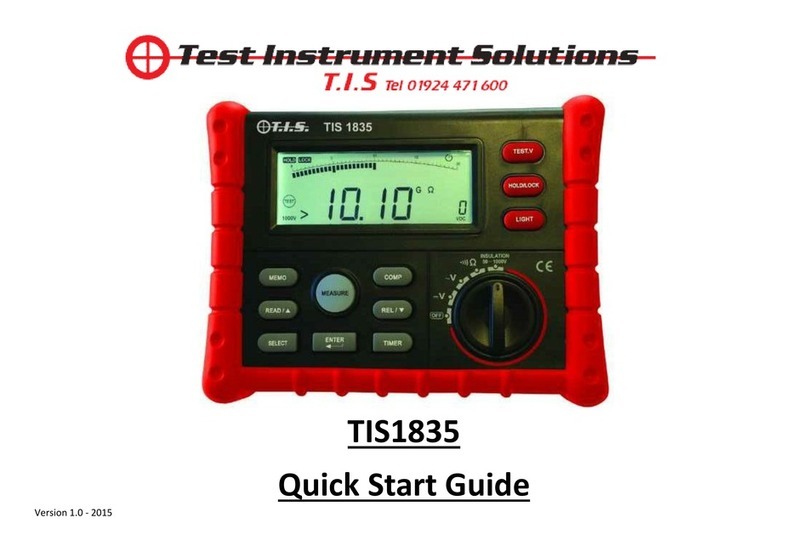
T.I.S.
T.I.S. TIS1835 quick start guide
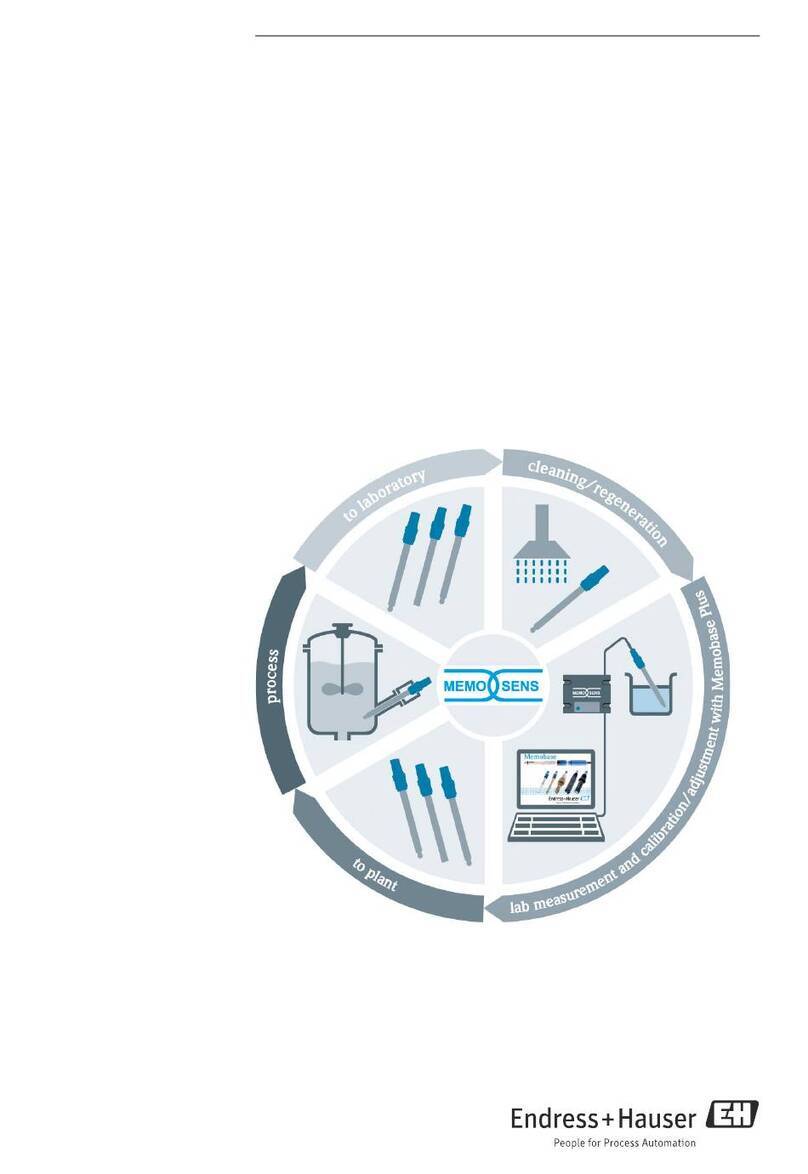
Endress+Hauser
Endress+Hauser Memobase Plus CYZ71D operating instructions
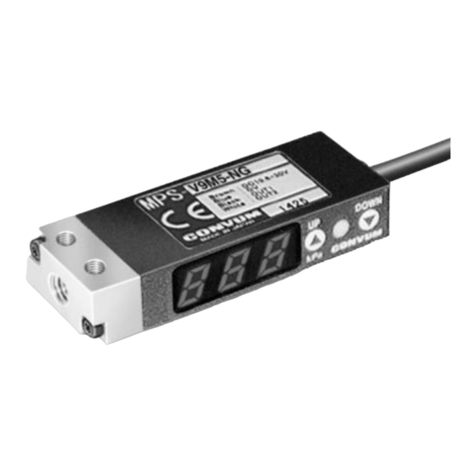
Parker Pneumatic
Parker Pneumatic MPS-9 Series Installation & service instructions
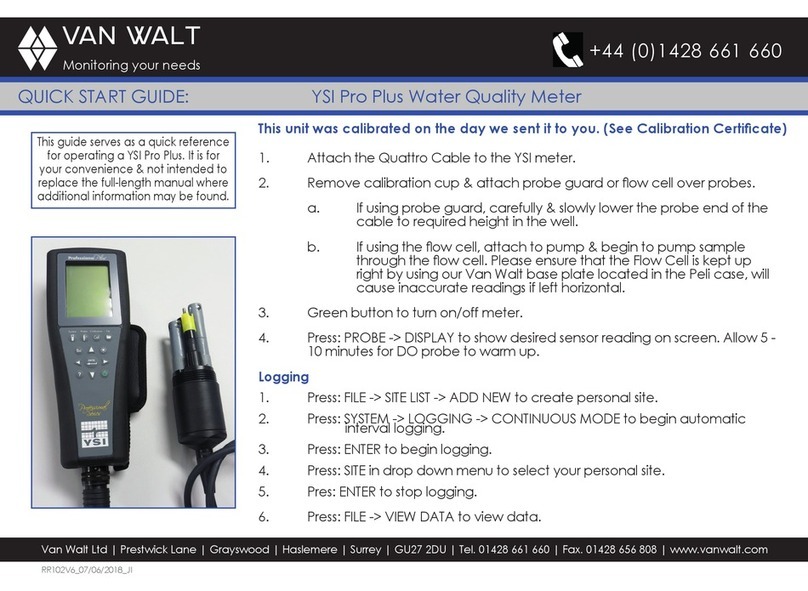
Van Walt
Van Walt YSI Pro Plus quick start guide
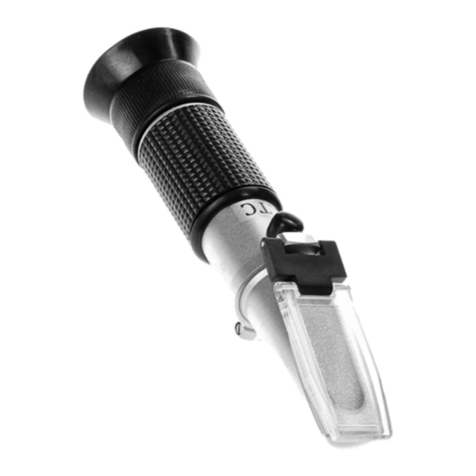
SIXTOL
SIXTOL SX3002 Instructions for use

DAKOTA ULTRASONICS
DAKOTA ULTRASONICS MAX II manual
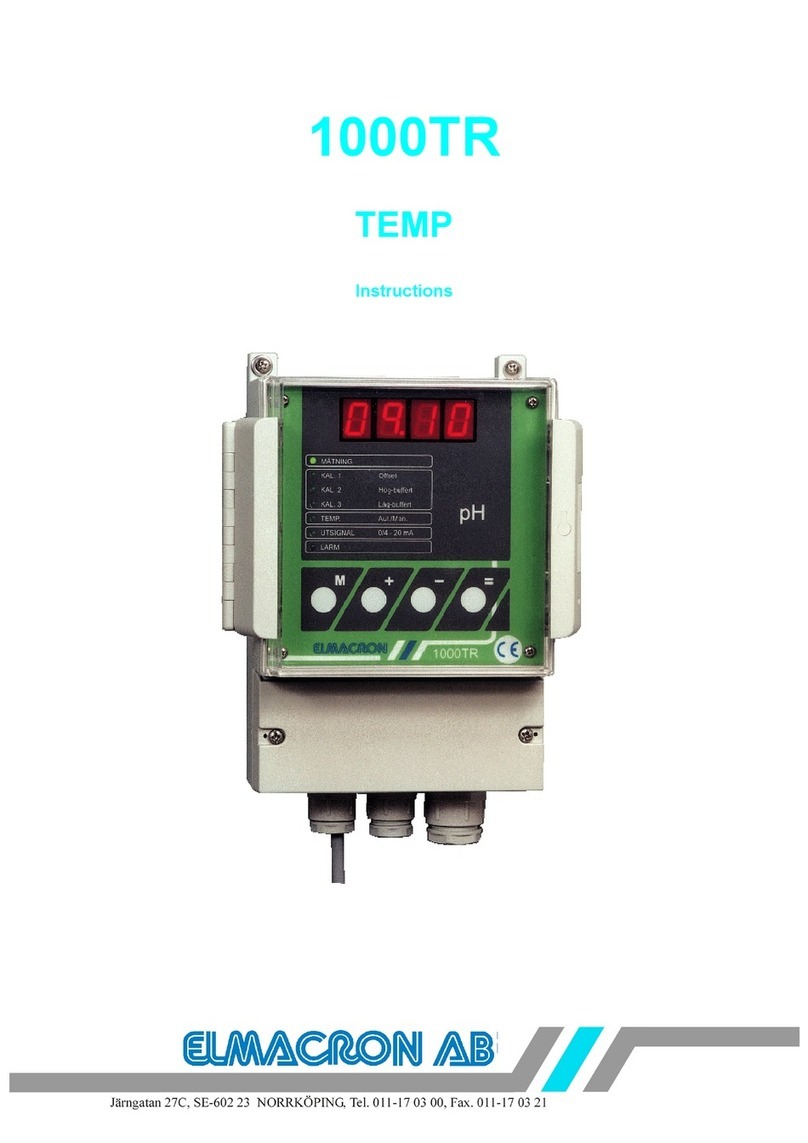
ELMACRON
ELMACRON 1000TR instructions

PST
PST CENTER 24 instruction manual

Marvel
Marvel 3165 Operation and service
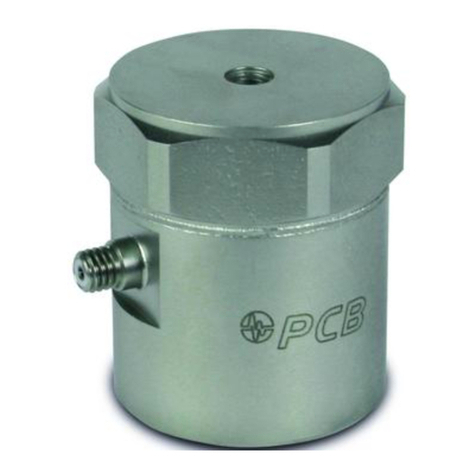
PCB Piezotronics
PCB Piezotronics ICP 301A10 Installation and operating manual

Leica Geosystems
Leica Geosystems DISTO WH15 Technical reference manual

